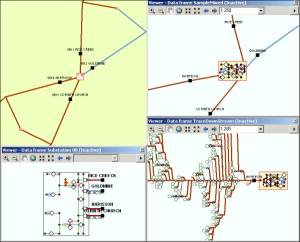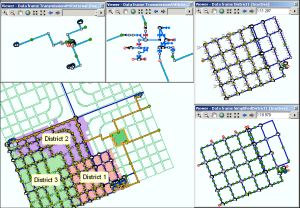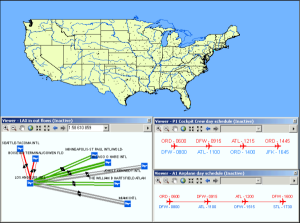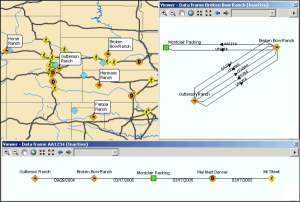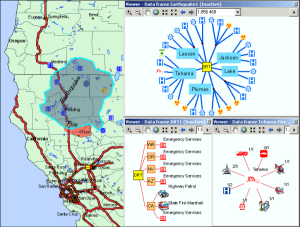What are schematics
Schematics are simplified representations of networks, intended to explain their structure and make the way they operate understandable.
Schematics can be used to represent any type of network within a defined space without scaling constraints. For example, a defined space is a piece of paper where numerous pieces of information are displayed by optimizing the placement of the features. Within schematics, there are no scale constraints (cable length, distances, and so forth).
The ArcGIS Schematics extension
ArcGIS Schematics is an extension to ArcGIS for Desktop (Advanced, Standard, and Basic) and ArcGIS for Server.
ArcGIS Schematics automatically generates geo-schematic and pure schematic views from existing network data, thus limiting the number of operations needed to build architecture and maintain network data updates. ArcGIS Schematics provides greater return on investment by saving you time and money.
By allowing users to efficiently create multilevel representations, readily check network connectivity, and easily obtain logical views of any linear network, ArcGIS Schematics improves efficiency and facilitates the decision-making process.
Schematics users can manage physical and logical networks, including social and economic networks, and may view and represent any kind of network: electric power, traffic light, delivery route, computer, and so forth. It enables users to automatically generate, visualize, and manipulate diagrams from network data or data that has attributes for connectivity.
Schematics sample applications
Schematics and utilities
Telecommunications, energy, water, transportation, electric and gas, petroleum and pipeline, hydrology, defense and intelligence, local government use schematics to:
- Schematically view their network data.
- Evaluate existing networks and plan network evolution.
- Model and design their networks.
- Distinguish topological relationships.
- Find ways to optimize their systems.
Schematics in the Electric industry
In the Electric industry, Schematics can be used to produce:
- Diagrams from electric GIS features mixed with nonspatial objects, which show the internal connections of an electric facility.
- Interior substation diagrams that are not normally viewable in the GIS.
Schematics in the Water industry
In the Water industry, Schematics can be used to build different types of schematic diagrams:
- Transmission or distribution diagrams
- Pumping station plant
- Water network diagrams per district, county, and so on
- Simplified diagrams of water equipment to clearly highlight the elements that control the valves in the network
Schematics and nontraditional applications
Other sectors that benefit from ArcGIS Schematics include:
- Logistics
- Local government
- Intelligence
- Epidemiology
- Criminology
- Defense
Managing flowcharts and schedules with Schematics
In airports or airline companies, Schematics can be used to manage flowcharts and schedule:
- Generate flowcharts that provide synthetic maps to show flight lines according to their passenger flows
- Manage flight sequence or schedule diagrams for cockpit crews or airplanes
Tracking and managing distribution or supply chain with Schematics
Schematics can be used for tracking, supply chain, and distribution management. For example, it can help in tracking animal movements between premises for the purpose of showing a supply chain or for distribution management.
- Schematic diagrams generated from a ranch GIS feature can show all the animal movements that happen in a week for any animal reared in that ranch.
- A diagram can track a particular animal from its place of birth to market.
Managing operations with Schematics
Schematics can be used to help in managing operations; for example, rescue resources when disasters such as earthquakes, fires, and hurricanes hit a region.
- Starting from a disaster polygon GIS feature, Schematics can be used to generate a diagram that shows all the counties that are impacted and the local emergency agencies that could help in those counties or all the related state emergency agencies that could help.
- It can also be used to produce diagrams that show the availability of rescue equipment per emergency agency

